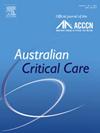当前儿科重症监护病房随访服务的提供和看法:一项两国组织和临床医生调查
IF 2.7
3区 医学
Q2 CRITICAL CARE MEDICINE
引用次数: 0
摘要
本研究的目的是(i)评估澳大利亚和新西兰对儿科重症监护存活儿童的随访服务;(ii)评估临床医生和整个服务部门对重症监护后综合症儿科的知识;(三)确定儿科重症监护病房住院后长期随访服务的障碍。方法针对组织领导和个人临床医生受访者设计了两项基于网络的横断面REDCap调查。邀请澳大利亚和新西兰所有配备人员儿科病床的儿科重症监护病房参加。结果6个儿科重症监护病房和345名临床医生参与了两项调查。11个儿科重症监护病房中没有一个报告有任何专门的门诊随访服务。在调查之前,只有53%的临床医生听说过重症监护后综合征-儿科这个术语。然而,大多数临床医生认为,应通过多学科团队(32%)开展的多种模式(49%)(例如远程保健和面对面),为儿童在儿科重症监护病房入院后提供随访护理(96%)。个人临床医生和组织领导受访者都认为人员配备和预算限制是随访护理的最大障碍。尽管越来越多的国际证据支持儿科重症监护病房随访服务的实施,但澳大利亚和新西兰的儿科重症监护病房目前并未提供此类服务。在实施儿科重症监护病房后续做法时,需要解决人员配置和预算限制问题。提高临床医生和整个组织对重症监护后综合征-儿科及其影响的认识和理解,也可能有助于减少在澳大利亚和新西兰儿科重症监护室实施后续服务的障碍。本文章由计算机程序翻译,如有差异,请以英文原文为准。
Current provision and perceptions of paediatric intensive care unit follow-up services: A binational organisational and clinician survey
Objectives
The aim of this study was to (i) evaluate follow-up services in Australia and New Zealand for children surviving paediatric intensive care; (ii) assess clinician and service-wide knowledge of post–intensive care syndrome-paediatrics; and (iii) identify barriers to long-term follow-up services post paediatric intensive care unit admission.
Methods
Two cross-sectional, web-based REDCap surveys were designed for organisational leadership and individual clinician respondents. All paediatric intensive care units with staffed paediatric beds in Australia and New Zealand were invited to participate.
Results
Eleven paediatric intensive care units and 345 clinicians responded to the two surveys. None of the 11 paediatric intensive care units reported having any dedicated outpatient follow-up services. Only 53% of clinicians had heard of the term post–intensive care syndrome-paediatrics prior to the survey. However, most clinicians believed that follow-up care should be provided to children following a paediatric intensive care unit admission (96%) via a combination of modalities (49%) (e.g., telehealth and face-to-face) conducted by a multidisciplinary team (32%). Both the individual clinicians and the organisational leadership respondents identified staffing and budget restraints as the biggest barriers to follow-up care.
Conclusions
Despite growing international evidence to support the implementation of paediatric intensive care unit follow-up services, Australian and New Zealand paediatric intensive care units do not currently offer such services. In implementing paediatric intensive care unit follow-up practices, staffing and budgetary restraints need to be addressed. Improving clinician- and organisation-wide awareness and understanding of post–intensive care syndrome-paediatrics and its impacts may also help to reduce barriers to implementing follow-up services in Australian and New Zealand paediatric intensive care units.
求助全文
通过发布文献求助,成功后即可免费获取论文全文。
去求助
来源期刊

Australian Critical Care
NURSING-NURSING
CiteScore
4.90
自引率
9.10%
发文量
148
审稿时长
>12 weeks
期刊介绍:
Australian Critical Care is the official journal of the Australian College of Critical Care Nurses (ACCCN). It is a bi-monthly peer-reviewed journal, providing clinically relevant research, reviews and articles of interest to the critical care community. Australian Critical Care publishes peer-reviewed scholarly papers that report research findings, research-based reviews, discussion papers and commentaries which are of interest to an international readership of critical care practitioners, educators, administrators and researchers. Interprofessional articles are welcomed.
 求助内容:
求助内容: 应助结果提醒方式:
应助结果提醒方式:


